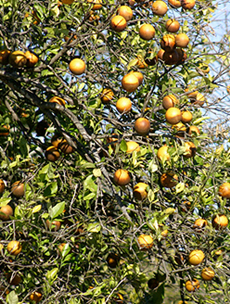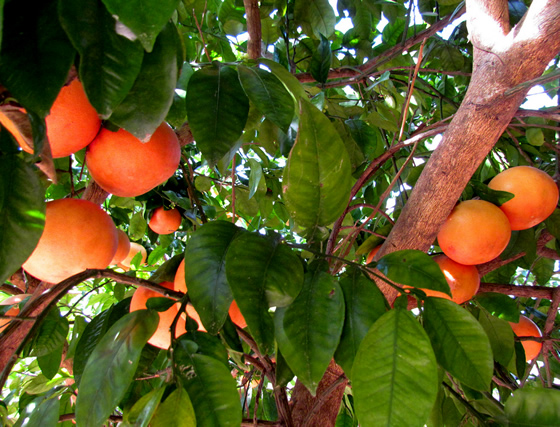 |
| Fruit crops |
Fruits are mature, or ripened, ovaries of angiosperms, their contents, and any accompanying accessory structures. From a botanical point of view, common foods such as grains, nuts, dried beans, squash, eggplant, and tomatoes are fruits, but in common usage the term is usually restricted to fleshy fruits that are commonly grown commercially as crops and are eaten, primarily raw, for their fleshy and juicy pulp.
Fertilization of ovules and the initiation of seed development lead to hormone production that triggers fruit development. Consequently, fruits usually contain seeds, but seeds can form without fertilization (parthenogenesis), and fruits can develop without seeds (parthenocarpy).
Many fruits that are cooked or eaten as part of a main course are usually classed as vegetables. This dichotomy is reflected in the origins of the two words: fruit, from the Latin fruor, “to enjoy,” and vegetable, from the Latin vegetare, “to enliven.”
 |  |
Ecology of Fruits
In nature, fleshy fruits serve as a reward for seed-dispersing animals. In keeping with the evolutionary principle that selection tends to minimize the cost of structures while maximizing their function, the flesh of these fruits contains comparatively few calories and basically consists of colored, flavored sugar water.
Using animals as dispersal agents carries a risk, however, of seed destruction. Consequently, fleshy fruits that are dispersed by animals exhibit a number of mechanisms that protect seeds.
One of these is the production of a large, hard seed that an animal cannot eat, such as a peach pit or a mango seed. Another protective characteristic is small seeds that go through an animal’s digestive system without being crushed or digested, such as strawberry seeds.
Over the last ten thousand years that humans have been practicing agriculture, many fleshy fruited species have been domesticated and bred for improved fruit production and quality. Several of the most marketed fruits worldwide are discussed below.
Temperate Fruits
The rose family (Rosaceae) contains a wide array of fruits grown in the cool regions of the world: apples, pears, plums, peaches, cherries, strawberries, and raspberries.
Apples are the most important fruit tree crop of temperate regions. Apple and pear fruits are known as pomes because the edible fleshy part of the fruit is a combination of the outer ovary wall and the basal part of the flower.
   |
Cultivated apples are believed to have originated in western Asia and were enjoyed in prehistoric times. Apples were brought to North America about 1620 and are now the most widely grown fruit in the United States.
Most of the apples grown today are diploids, but many are triploids. Orchards are usually planted with grafted trees, to ensure uniformity of the crop. Literally thousands of varieties of apples have been developed over the centuries since the species was domesticated.
Plums, peaches, and cherries come from different species of the genus Prunus. They share a fruit type known as a drupe, consisting of a fleshy mesocarp and a single seed inside of a hard endocarp. While there are native species of Prunus in the New World, the domesticated species are native to Eurasia.
The modern cultivated strawberry is a hybrid that apparently formed spontaneously in a European garden between a species of Fragaria from Chile and one from Virginia.
Europeans had eaten native strawberries for centuries before the discovery of the New World, but the hybrid (Fragaria ananassa) was larger in size, as flavorful, and produced more fruit. A strawberry is actually an aggregation of fruits, or aggregate fruit.
Each tiny seed is itself a fruit. The large, succulent, mass is the swollen top of the stem on which the flower was borne. Raspberries are also aggregated fruits, but each globular segment of the raspberry is itself a fruit, called a drupelet. The caps of drupelets pull free of the stem tips when the berry is picked.
Grapes are the second most widely cultivated fleshy fruit (on a tonnage-produced basis). However, the majority of grapes are not eaten as fruit but are turned into other foods, such as vinegar, liqueurs, raisins, and wine.
 |
| Grapes |
The most widely cultivated species of grape is Vitis vinifera (Vitaceae), a woody perennial vine native to middle Asia. There are hundreds of varieties of grapes that vary in the color of the skin, flesh, flavor, and sweetness of the berries.
Nuts are dry fruits, each of which contains a single seed that is free inside the ovary wall, except for an attachment at one end called the funiculus. The pericarp (the walls of the ovary) is hard and fibrous. Commercially grown nuts include filberts, pecans, walnuts, and macadamia nuts, sold both for eating and for cooking.
Tropical Fruits
Many species of the genus Citrus (including sweet orange, tangerine, grapefruit, lemon, and lime) are grown for their edible fruits. Sweet oranges (Citrus sinensis) are the most widely grown fruit in the world, but in the nineteenth century they were considered luxuries and prescribed as cold remedies by physicians.
Like other citrus fruits, the fruit of an orange is technically a hesperidium, a berry with a leathery rind and a juicy pulp that is formed of juice sacks borne on the inner layer of the fruit wall.
 |
| Tropical Fruits |
Navel oranges, favored for eating, are the result of a mutation that produces a second ovarylike structure (the navel) instead of seeds. Because they are seedless, navel oranges are all propagated by grafting. Blood oranges are seeded oranges named for the patches of deep red-purple color in the fruit.
Bananas became amajor fruit crop in the twentieth century; prior to the use of refrigerated ships, bananas spoiled before they could reach markets outside the tropics.
Wild bananas, native to eastern Asia, have seeds, but the common domesticated banana (Musa paradisiaca) is seedless and is the product of several cycles of hybridization followed by increases in chromosome number. Whether the fruit will be a tender and sweet yellow or red or a tough, starchy green plantain depends on the particular combination of chromosomes in the hybrid.
Banana plants are giant herbs, not trees, and are propagated vegetatively by planting a piece of stem.Over the course of a year, the stem grows and produces a long terminal inflorescence of many clusters of female flowers along the flowering stalk and male flowers at the tip.
The female flowers spontaneously mature, with each cluster forming a hand, or bunch, of bananas. An entire inflorescence can produce more than three hundred bananas, weighing 110 pounds. After fruiting, the shoot dies and is cut, allowing a sprout from the base to produce the next flowering stem.
Mangoes (Mangifera indica) are extremely common and important fruits in tropical areas, particularly in their native region of Southeast Asia, where the fruit pulp and even the seeds have been used for food. Mangoes are borne on trees that can grow only within tropical regions where there is adequate water in the summer.
The fruit is a berry with musky yellow flesh surrounding a single large seed. Mangoes belong to the poison ivy family; some people are allergic to the latex produced in the skins. Mangoes were introduced into Brazil by the Portuguese in the early 1700’s and subsequently spread to other areas of the New World tropics.
 |
| Mangoes (Mangifera indica) |
Melons, both common melons (Cucumis melo) and watermelons (Citrullus lanatus) belong to the same family (Cucurbitaceae) as squashes, but the latter are all native to the New World and the former to the Old World.
All these species share the same kind of fruit, a pepo, which consists of a hard rind derived in part from the basal parts of the flower, and an edible fleshy layer of inner ovary tissue. Melons are monoecious vines with showy male and female flowers that require pollination to set fruit.
Melons are native to Africa, where they were undoubtedly prized for their high water content and fresh flavor. Selection has led to numerous varieties, including cantaloupe, Crenshaw, honeydew, Persian, musk, and a variety of other melons that differ in the color and surface of the rind, color of the flesh, taste, and degree of sweetness.
Watermelons are native to sub-Saharan Africa, but they can be grown in temperate regions because they are annuals. The flesh is 87-92 percent water and is acidic enough to curdle milk. Recently, seedless types have been produced by artificially making triploid plants.
The pollen of these triploids is sterile, and the seeds abort early. Farmers plant the triploids with fertile diploids. Pollen from the diploids fertilizes the ovules of the triploids and triggers fruit production. The seeds quickly die, but the fruit continues to mature into a seedless water-melon.
